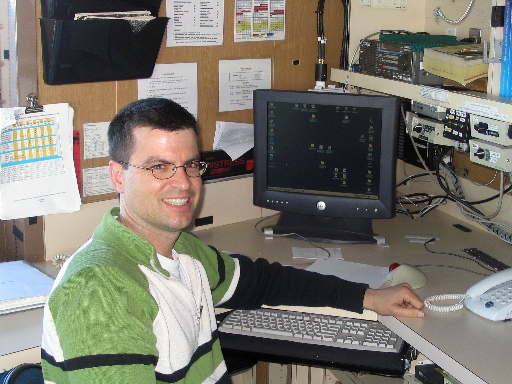( Log In ) Log In is for TREC Teachers & Researchers only
  |
| Betty_Carvellas |
 Jul 7 2006, 05:13 PM Jul 7 2006, 05:13 PM
Post
#1
|
 TEA Teacher    Group: TEA Teacher Posts: 41 Joined: 6-July 05 Member No.: 20 |
July 5, 2006
Considering that Jackie is not even on board yet and our real work hasn't started, it was a very busy day. After our bongo station this morning, I spent time in the engine room talking with second engineer Laurie La Plante. I met Laurie in the Motor Control Room. From there I could look out and see the 3 locomotive engines that actually power the ship. To put it into perspective, each engine has 2,950 brake horsepower. On a good day with no ice and smooth waters, the ship will maintain 10.5 knots with one engine running, 13-14 knots with two running and, with all three, it can maintain 16 knots. That all changes, of course, when the ship is doing what it is built to do - break ice. The ship can easily break ice 3-4 four feet (1-1.5 meters) thick and can even break 6 feet of new ice (first year). However, anything over 2 meters is tough, and fuel use doubles when the ship is breaking ice. How much fuel does the Laurier actually use in a 12 hour period? The answer is almost 19,000 liters with two engines running. That's enough to heat an average size home in a cool climate for about 30 years! The engine room runs with two crew members/watch, each on a 12 hour shift. Instruments in the Motor Control Room duplicate directional signals from the bridge that are then passed on to the propellers. The Control Room also houses a mimic board that shows all pieces of equipment that are currently running, a computerized alarm and monitoring system, and communications to any station on the ship and to shore. Unfortunately the pictures of Laurie were blurry, and when he was on duty again, my camera batteries had died. I'll post a picture of Laurie in the Motor Control Room in an upcoming journal. After visiting with Laurie in the engine room, I went out to the well deck to watch Dr. Bill Williams and Stephanie King get the ARGO float ready for deployment. They carefully checked everything before lowering it over the side. The ARGO float will drift and continually transmit temperature, salinity, pressure, and dissolved oxygen data for approximately 3 years. The float moves between the surface and a depth of 2000 meters, resting at the 2000 m. depth for a period of time to drift with the ocean currents to a new location. It records a profile each time it rises to the surface or goes back down. Similar ARGO floats are in waters all over the world; their signals are picked up by satellite and downloaded. Anyone can access the data by going to the ARGO website. We're trying to track that down at the moment, and I'll try to post it tomorrow.  Dr. Bill Willams and Stephanie put the Argo float in over the side of the ship. The float will transmit temperature, salinity, pressre,and dissolved oxygen data for approximately three years. After lunch, I worked with Gerald Rohatensky, ship's computer specialist, to check the TREC site for my journals and finish getting my computer set up in my room. We don't have internet access on board ship (except for special occasions) so I can't see if everything is getting posted correctly. I was happy to see that everything was in place. When the science crew first comes on, it seems that I hear, several times each day, "Gerald, when you have a minute, could you check something for me?" Gerald goes from his home base on the bridge to the lab, individual rooms, the aft deck computer, to the van on deck, and wherever anyone else needs him, always with a smile on his face!  Gerald Rohatensky, ship's computer specialist, is always on hand to help the scientists, and everyone else on board. He's been a great help to me. I then moved to the aft deck (on the stern) to watch Stephanie King complete the hourly XBT (Expendable Bathy Thermograh) launch. The XBT is released once each hour round the clock. Check out the picture, and I'll tell you more about it tomorrow.  Once every hour around the clock, someone launches an XBT (Expendable Bathy Thermograph) from the stern. From the aft deck, I moved to the ship's hold to work with Dr. Rebecca Woodgate. She was kind enough to invite me along to help check her mooring releases even though she could have done it alone. She uses a dual release mechanism with one as a back up in case the first fails. When you have many thousands of dollars worth of equipment in the water, you definitely want to get it back! I'll be telling you much more about Rebecca's work in a future journal entry. We wrapped up our last bongo station around 8:30. All in all, a very busy day! |
  |
1 User(s) are reading this topic (1 Guests and 0 Anonymous Users)
0 Members:

|
NSF Acknowledgment & Disclaimer | Time is now: 11th November 2024 - 11:20 PM |
Invision Power Board
v2.1.7 © 2024 IPS, Inc.








